
Job Search and Networking
LinkedIn Basics
Introduction

With more than 175 million members worldwide, LinkedIn is the largest social media site dedicated solely to professional networking. While LinkedIn's popularity has continued to increase among job seekers and employers, it's not always clear how to use the site to its full potential.
In this module, you'll learn about the basics of using LinkedIn. We'll also talk about different strategies you can use to create an effective LinkedIn profile, add new contacts, join groups, and search for jobs.
What is LinkedIn?
Unlike other social networking sites, LinkedIn was created specifically for professional networking—the act of building and maintaining a group of contacts to help advance your career.
LinkedIn allows you to create a professional profile, a brief summary of your skills, work history, and recommendations that serves as a kind of online resume. You can also add different contacts, known as connections, to build your network.
Watch this introductory video from LinkedIn to learn more.
Why use LinkedIn?
It's important to remember that a majority of job seekers found their most recent position by networking, either through referrals or direct contact with a hiring manager. LinkedIn is an ideal tool for expanding your professional network. Whether you're reaching out to colleagues you already know or establishing new relationships with people in your field, you'll be able to stay organized and keep in touch with your connections.
More employers have also begun using LinkedIn to screen and recruit potential candidates. Creating an effective profile and building connections could make a significant difference when searching for your next job. With the right approach, you might even have employers contacting you about the latest job openings.
Getting started
To create a LinkedIn account, simply go to www.linkedin.com. After you enter your basic information, LinkedIn will guide you through the process of creating your account step by step.
If you've never used any kind of online networking site before, LinkedIn can seem a little intimidating at first glance. Fortunately, the site has created a series of resources that will have you navigating through it like an expert in no time. Even if you're already an experienced user of other social networking platforms like Facebook or Twitter, you'll need to take some time to learn how to use LinkedIn's different features.
Navigate to some of the different training resources about LinkedIn below:
- Mashable offers a comprehensive basic tutorial, LinkedIn: The Beginner's Guide, which will tell you everything you need to know to get started on LinkedIn.
- The LinkedIn Help Center offers the best place to find answers to commonly asked questions and to learn more about the features of the site, like groups and the Job Search tool.
- LinkedIn also offers free webinars on several different topics, including LinkedIn 101. These webinars are a great way to learn directly from experienced LinkedIn users and staff members.
LinkedIn strategies
Once you've become familiar with LinkedIn's features, you're ready to start using the site to build your network. It's important to realize, however, that everyone will use the site differently. Some people are interested in building new connections, while others remain focused on staying in touch with their network—it's all about discovering what works best for you. No matter how you plan to use LinkedIn, there are several strategies you can adopt to make the most of your time on the site.
Creating an effective profile
Your profile is the first thing people will see on LinkedIn. You should treat your profile exactly as you would a resume, taking the time to make sure it is complete, accurate, and professional. Check out LinkedIn's Introduction to Profiles to learn more about your profile page.
Your profile should contain all of the information you would normally include on a resume, such as your education, skills, and work history. But LinkedIn also allows you to add information you might not include on a traditional resume, like a profile picture and personal summary.
Review some of the different techniques below to learn how to create an effective LinkedIn profile:
- Choose your privacy settings
Your LinkedIn profile can be as public or private as you choose. By default, your basic information will be viewable to anyone, even if they don't have a LinkedIn account. Your privacy settings will ultimately depend on how you plan to use the site. You might set stronger privacy controls if you only plan to connect with people you already know, while a more public profile may make it easier to build new connections. Visit LinkedIn's page on Settings & Personalization to learn more about changing your privacy settings.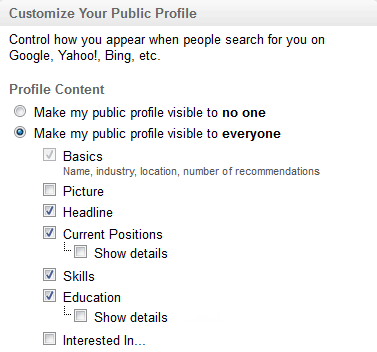 Choosing your privacy settings
Choosing your privacy settings - Use a professional photo
Uploading a photo to your profile can help you leave the right impression. While it should still reflect your personality, the picture should be as professional as possible. Try using the same photo for all of your current social media accounts to create a unified presence across your networks.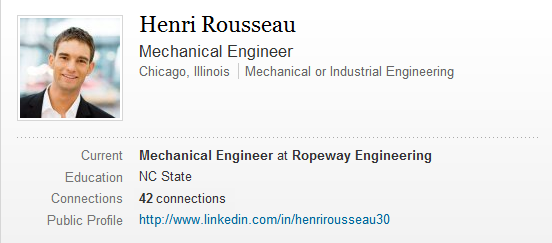 A LinkedIn profile page with a professional photo
A LinkedIn profile page with a professional photo - Customize your introduction
Your headline and summary provide a quick snapshot of your skills and interests. These sections are a great place to include your personal elevator pitch—a brief introduction that explains your strengths to potential connections and employers. Visit our lesson on Networking Basics to learn more about crafting your elevator pitch. A personal summary
A personal summary - Stay current
Your profile should always contain the latest information about your skills, education, and work history. Update your profile whenever you take on a different position or learn a new skill. You'll also want to customize your contact preferences so people know what you're looking for.
 Experience, skills, education, and contact preferences
Experience, skills, education, and contact preferences
If you're concerned about sharing too much of your personal information on LinkedIn, such as your education and work history, consider excluding the specific dates or names of employers from your profile. See our lesson on Protecting Your Identity With a Cyber-Safe Resume to learn more.
Adding connections
LinkedIn makes it easy to add new and existing contacts, known as connections, to your online network. But unlike traditional networking, LinkedIn also allows you to visualize your secondary network—the people you could possibly meet through your connections. While this secondary network already exists offline, LinkedIn gives you an opportunity to explore these potential connections like never before. The more connections you can make on LinkedIn, the larger your secondary network will become.
Try using some of the different strategies below to help you add new connections and grow your network:
- Add your current network
LinkedIn isn't just about finding new connections. When you first create a LinkedIn profile, make sure to connect with the people you already know. Try syncing your email contacts and using LinkedIn's robust search feature to find friends, classmates, current and former coworkers, and employers. Your existing network might be much larger than you think.
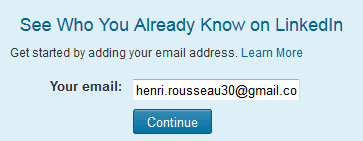 Adding connections from your email contacts
Adding connections from your email contacts - Follow up
Whenever you make a professional connection offline, ask if you can connect on LinkedIn. Even if you only have a few moments to meet in person, LinkedIn can give you an opportunity to learn more about one another and develop a professional relationship over time. Sending a LinkedIn invitation
Sending a LinkedIn invitation - Ask for introductions
If you're trying to connect with someone you've never met, you should first look to see if you have any mutual connections. If so, you can ask your connections for an introduction. Be sure to be courteous and detailed about why you are requesting the introduction, and give your connection an opportunity to decline the request.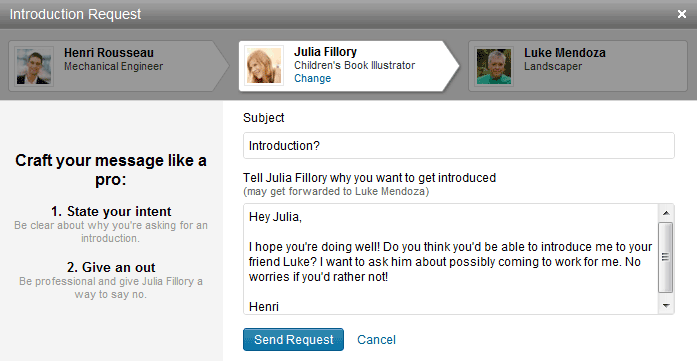 Requesting an introduction
Requesting an introduction - Introduce yourself
Sometimes you may want to connect with someone who doesn't share any mutual connections, such as a hiring manager. While you should mainly try to connect with people you know in person, sometimes a well-placed introduction can lead to new opportunities. When connecting with anyone on LinkedIn, you should never send a default invitation letter—be specific and clear about why you want to make a connection.
Check out Mashable's 7 Lessons for Better Networking with Social Media to learn more strategies for connecting with people online.
Joining the conversation
The most successful LinkedIn users are consistently looking for new connections, participating in conversations, and keeping in touch with their contacts. Dedicating just a few minutes each day will help you maintain an active presence on the site.
Try using the strategies below to become a more active and involved member of LinkedIn:
- Update your status
Just like other social networking sites, LinkedIn allows you to update your status whenever you choose in a short, text-based post. Your status is shared with all of your connections, so it's a great way to share your ideas, opinions, and interesting links. A LinkedIn status update
A LinkedIn status update - Join groups
One of the best ways to make new connections and develop a strong presence on LinkedIn is to become a member of a LinkedIn group. With more than 1 million groups focusing on a range of topics, there's probably a group that will interest you. Try participating in some groups that focus on your industry or that help users reconnect with alumni from your college. You might even consider creating your own group if you feel people would be interested in joining a new discussion. A LinkedIn group
A LinkedIn group
Searching for jobs
LinkedIn can be an incredibly powerful tool in your next job search. You can harness the power of your network to search for opportunities, seek out referrals, and ask for recommendations. LinkedIn also features different tools that allow you to search for jobs directly through your account. If you're just getting started, the LinkedIn Help Center provides a variety of tips and resources and answers to commonly asked questions to help you on your job search.
Try using some of the different techniques below to get the most out of your LinkedIn job search:
- Use your network
Putting your network to work for you is one of the most effective ways to find a job, so be sure to let your connections know when you're looking for a new position. At the same time, be careful not to overwhelm your network with constant updates and requests. Try asking for advice rather than asking for a job—most people will be happy to share their knowledge and help you look for opportunities. - Use the Job Search tool
LinkedIn allows employers to post different opportunities using the Job Search tool, much like any online job board. But unlike other job boards, LinkedIn also gives you the opportunity to connect directly with an employer and see if you have any connection to the hiring manager. Having the right connections could make it much easier to find your next job.
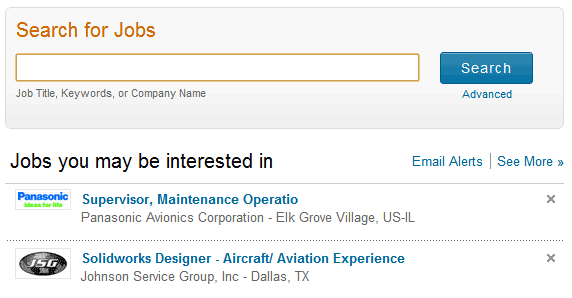 The LinkedIn Job Search Tool
The LinkedIn Job Search Tool - Connect with employers
Rather than wait for the next job postings to appear, you can take a more active approach by reaching out to employers. LinkedIn allows you to follow different companies, so you'll be able to keep up with the latest trends and opportunities from employers you care about. You might also consider connecting with a hiring manager at a company you'd like to work for, even if there aren't any positions currently available. Just letting someone know you're interested could pay off when a new position opens up.
 A company page on LinkedIn
A company page on LinkedInAdditional resources
The strategies introduced in this lesson are meant to provide a helpful baseline as you begin using LinkedIn to build your professional network. You will need to experiment with different techniques to find what works best for you. Check out some of the resources below to discover even more ways to use LinkedIn:
 The LinkedIn app on an iPad
The LinkedIn app on an iPad- Mobile apps
The sooner you can make a new connection on LinkedIn, the better. You can download the official LinkedIn mobile app and stay connected wherever you go. You might also check out CardMunch, which allows you to take a photo of a business card and instantly connect with that person on LinkedIn.
- Follow expert advice
Everyone uses LinkedIn differently, but there's no harm in learning from some of its most successful users. Try following different LinkedIn experts like Jason Alba (I'm on LinkedIn, Now What?), Neil Schaffer (LinkedIn 101), or Nate Kievman (LinkedIn Strategies). You can also stay on top of the latest LinkedIn news by reading Mashable and the official LinkedIn Blog.